Cnut the Great
| Cnut the Great | |
|---|---|

A 14th century portrait of Cnut the Great
|
|
| King of England | |
| Reign | 1016–1035 |
| Coronation | 6 January 1017 in Old St Paul's Cathedral, London, England |
| Predecessor | Edmund Ironside |
| Successor | Harold Harefoot |
| King of Denmark | |
| Reign | 1018–1035 |
| Predecessor | Harald II |
| Successor | Harthacnut |
| King of Norway | |
| Reign | 1028–1035 |
| Predecessor | St Olaf II |
| Successor | Magnus the Good |
| Born | c. 995 Denmark |
| Died | 12 November 1035 (aged 40) Shaftesbury, Dorset, England |
| Burial | Old Minster, Winchester, England. Bones now in Winchester Cathedral, Winchester, England |
| Spouse | |
| Issue |
|
| House | Denmark |
| Father | Sweyn Forkbeard |
| Mother | unknown (Świętosława / Sigrid/ Gunhild) |
| Religion | Catholic |
King Cnut the Great (Old Norse: Knútr inn ríki;c. 995 – 12 November 1035), also known as Canute, was King of Denmark, England, and Norway, together often referred to as the Anglo-Scandinavian or North Sea Empire. After his death, the deaths of his heirs within a decade, and the Norman conquest of England in 1066, his legacy was mostly forgotten. The medieval historian Norman Cantor said he was "the most effective king in Anglo-Saxon history", though he was Danish and not a Briton or Anglo-Saxon.
Cnut is popularly invoked in the context of the legend of King Canute and the waves, which usually represents him as a deluded monarch believing he has supernatural powers, contrary to the original legend which portrays a wise king.
Cnut's father was Sweyn Forkbeard, King of Denmark (which gave Cnut the patronym Sweynsson, Old Norse Sveinsson). The identity of his mother is uncertain, although medieval tradition makes her a daughter of Mieszko I. As a Danish prince, Cnut won the throne of England in 1016 in the wake of centuries of Viking activity in northwestern Europe. His accession to the Danish throne in 1018 brought the crowns of England and Denmark together. Cnut maintained his power by uniting Danes and English under cultural bonds of wealth and custom, as well as by sheer brutality. After a decade of conflict with opponents in Scandinavia, Cnut claimed the crown of Norway in Trondheim in 1028. The Swedish city Sigtuna was held by Cnut. He had coins struck there that called him king, but there is no narrative record of his occupation.
The kingship of England lent the Danes an important link to the maritime zone between the islands of Great Britain and Ireland, where Cnut, like his father before him, had a strong interest and wielded much influence among the Norse–Gaels. Cnut's possession of England's dioceses and the continental Diocese of Denmark – with a claim laid upon it by the Holy Roman Empire's Archdiocese of Hamburg-Bremen—was a source of great leverage within the Catholic Church, gaining notable concessions from Pope Benedict VIII and his successor John XIX, such as one on the price of the pallium of his bishops, though they still had to travel to obtain the pallium. Cnut attempted to gain concessions on the tolls his people had to pay on the way to Rome from other magnates of medieval Christendom, at the coronation of the Holy Roman Emperor. After his 1026 victory against Norway and Sweden, and on his way to Rome for this coronation, Cnut, in a letter written for the benefit of his subjects, which only now exists in two twelfth-century Latin versions, deemed himself "King of all England and Denmark and the Norwegians and of some of the Swedes". The Anglo-Saxon kings used the title "king of the English". Cnut was ealles Engla landes cyning—"king of all England."
...
Wikipedia
